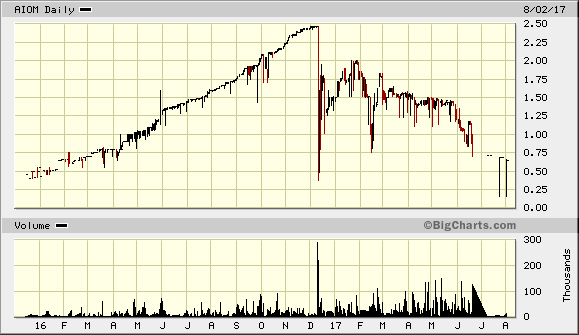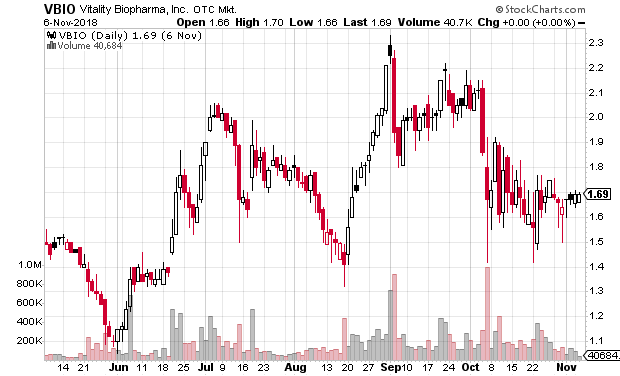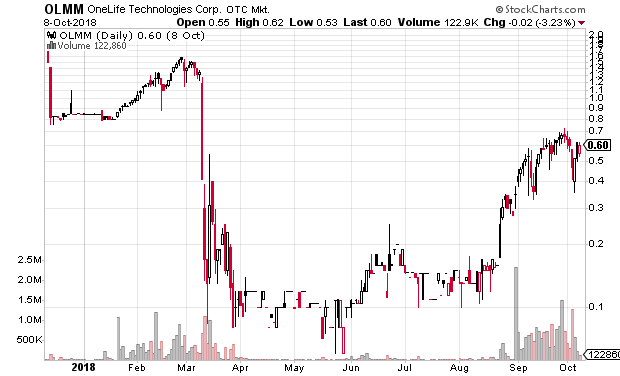When OTCMarkets designates a stock as Caveat Emptor (Buyer Beware), marked by the skull and crossbones, the stock will tend to drop and brokers and clearing firms may restrict deposits of new shares in that stock or at least do more careful due diligence on people depositing new shares of stock. Interactive Brokers will not let any client open new positions in any stocks marked Caveat Emptor. So Caveat Emptor designation is a big deal.

Here is OTCMarkets’ explanation of its policy on Caveat Emptor:
OTC Markets Group designates certain securities as ‘Caveat Emptor’ and places a skull and crossbones icon next to the stock symbol to inform investors that there may be reason to exercise additional care and perform thorough due diligence before making an investment decision in that security.
The Caveat Emptor Designation may be assigned when OTC Markets becomes aware of one or more of the following:
- Promotion — The security is the subject of stock promotion that may be misleading or manipulative. Promotional activities may include news releases, spam email, and newsletters, whether they are published by the issuer or a third party. See OTC Markets Group’s Policy on Stock Promotion.
- Investigation of Fraud or Other Criminal Activities — There is an investigation or other indication of fraudulent or other criminal activity involving the company, its securities or insiders.
- Suspension/Halt — A regulatory authority or an exchange has halted or suspended trading for public interest concerns (i.e. not a news or earnings halt).
- Undisclosed Corporate Actions — The security or company is the subject of a corporate action, such as a reverse merger, stock split, or name change, without adequate current information being publicly available.
- Other Public Interest Concern — OTC Markets Group may determine that there is a public interest concern regarding the security. Such concerns may include but are not limited to promotion, spam or disruptive corporate actions even when adequate current information is available.
When Does Caveat Emptor Get Removed?
Facts and circumstances may differ, however generally, OTC Markets Group will remove the Caveat Emptor designation once the company meets the qualifications for Pink Current Information, has verified the information on its company profile on www.otcmarkets.com, and demonstrates that there is no longer a public interest concern. The Caveat Emptor designation is typically not removed within the first 30 days. During the time it is labeled Caveat Emptor, any stock that is not in Pink Current Information will also have its quotes blocked on www.otcmarkets.com.
A June 1st, 2018 petition to terminate its SEC trading suspension (pdf) by Efuel EFN (EFLN) gives some details about the company’s attempt to have its Caveat Emptor designation removed. The statements made by Efuel EFN’s President are rather comical for their bad English. For example:
11. On September 15, 2017 OTC Markets designate Efuel as a Caveat Emptor. All financial statements are true and correct. There were NO perpetrated reports. Efuel is small micro cup company which we represent as true, real, stable, genuine, dedicated and committed. Efuel was using “Research Report” to file more information regarding company activities. Efuel made many attempts to reach upon OTC regarding CE status, to reveal to the company relevant factor for action.
…
[14.] d. Efuel states no new shares were issued since 2013, which are restricted shares exchanged for acquired property.
The SEC enforcement brief against Efuel’s motion to terminate the trading suspension gives a fair amount of detail (far more than OTCMarkets provides) about why Efuel EFN received Caveat Emptor designation in the first place:
II. OTC Markets Designates Efuel as a Caveat Emptor Issuer
On September 25, 2017, OTC Markets designated Efuel as a “Buyer Beware” or “Caveat Emptor” issuer. (May 21 Enright Aff. ¶11) The designation was due to concerns about Efuel’s public disclosures, financial statements, and purported “Research Reports.” These documents were public as they were filed on OTC Market’s website under Efuel’s listing. [Note by Michael Goode: Previous sentence was in footnote 2. Included in quote for clarity.] OTC Market’s concerns were based, among other things, on documents Efuel filed on OTC Market’s website, including:
(a) a May 21, 2017 “Research Report” titled “EFUEL CORPORATION HAS BEEN AUDITED BY DEPARTMENT OF REVENUE;”
(b) a May 5, 2017 “Research Report” titled “Euro-American Finance Network [sic] Inc. and [sic] Stefanovic Family Plan [$160 million] to Invest in Efuel EFN Corporation Projects;” and
(c) multiple balance sheets that did not balance, and did not include “cash” as an “asset.”
(May 21 Enright Aff. ,¶12) On January 2, Efuel sent a letter to OTC Markets, requesting that the Caveat Emptor designation on Efuel be removed. (Efuel Petition, Ex. A)
Efuel EFN then responded to OTCMarkets in an attempt to get Caveat Emptor designation removed:
III. Efuel Files Its 2017 Annual Statement on OTC Markets’ Website
On January 8, 2017, Efuel filed its purported financial statement with OTC Markets, claiming that the company had been audited by Mr. Stefanovic himself, through his firm EuroAmerican Financial Network, Inc. (“Euro-American”). (May 21 Enright Aff. ¶13)
IV. Efuel Sends an Attorney Opinion Letter to OTC Markets
On February 8, Efuel’s attorney, Mark E. Pena, sent a letter to OTC Markets regarding certain prior financial statements. (June 18 Enright Aff. Ex. 0). This letter is referenced in Efuel’s Petition, but is not attached to it as an exhibit. The Division includes it as an exhibit to the June 18 Enright Aff. for completeness of the record. [Note by Michael Goode: Previous sentence was in footnote 3. Included in quote for clarity.] The letter states that Mr. Pena has personally reviewed and discussed the financial statements with Mr. Stefanovic, and that Efuel’s 2017 financial statement complies with “Pink OTC Markets Guidelines for Providing Adequate Current Information.” Mr. Pena’s letter further states that: (i) the financial statement was internally prepared by the company in accordance with GAAP, with “auditing consultation” provided by Euro-American; (ii)he had the financial statement reviewed by an unidentified “local independent accounting firm specializing in public disclosure;” and (iii) that Efuel’s financial statement reports assets of over $519 million, with liabilities of approximately $3.7 million. The financial statement (which is only four pages) does not provide specific information as to what constitutes the $519 million in assets – only that Efuel supposedly has $15.1 million in “Property: Land, Building” and $500 million in “Land, Minerals, and Gold Deposit.” (June 18 Enright Aff. Ex. E, pg. 9) The financial statement does however, specifically state that it contains “audited results.” (June 18 Enright Aff. Ex. E, pg. 10) Efuel’s Petition (page 2) elaborates slightly by stating “Efuel holds 2905 acre land with 21 gold mining claims with minerals. Efuel is a small micro cup [sic] company which we represent as true, real stable, genuine, dedicated, and committed.” In its Petition, Efuel repeats the representation that it has over $519 million in assets, and only $3.7 million in liabilities. (Efuel Petition, pg. 3)
The SEC then gives OTCMarkets’ response detailing why it was not removing Caveat Emptor designation:
V. OTC Markets Declines to Remove the Caveat Emptor Designation
On February 23, 2018 OTC Markets sent a letter to Efuel stating “[w]e have completed our review of your December 31, 2017 Annual Report and related Attorney Letter and have determined that the information contained in these documents does not comply with OTC Pink Basic Disclosure Guidelines, therefore we are unable to remove the caveat emptor flag at this time. (May 21 Enright Aff. ,¶14 (Italics added)) OTC Markets’ letter further states that: “[i]n past reviews we have identified similar deficiencies to you and you continue to submit disclosure that does not resolve these deficiencies.” OTC Markets directed Efuel to submit revised financial reports and disclosure documents, a new attorney letter, and a letter from a U.S.-registered CPA certifying that the company’s financial reports were GAAP-compliant. (Id.) As of March 21, the date of the issuance of the trading suspension, Efuel had not submitted revised filings to OTC Markets in accordance with OTC Markets’ instructions. (May 21 Enright Aff. ¶15)
What can we conclude from this? OTCMarkets’ explanation of when it applies the Caveat Emptor designation and when it removes it is fairly complete at least when it comes to a company’s failures in disclosure. However, this does not provide clarity on the question of stock promotion and when that leads to the Caveat Emptor designation — I have seen some promoted stocks get designated Caveat Emptor and others not.
Trading in Efuel EFN (EFLN) stock was suspended by the SEC on March 21, 2018 (pdf). On May 7th, 2018 the SEC issued an order requesting additional submissions (pdf) stating that Efuel EFN was challenging the trading suspension and asking the company for more information. At the time I write this it appears that the administrative proceeding has not been decided. All relevant documents can be found on the administrative proceeding page for 3-18420.
I believe it unlikely that the SEC will grant Efuel EFN’s petition to remove the trading suspension given that the company is alleged by the SEC to have posted a false PR saying that the company was in compliance with OTCMarkets and the caveat emptor designation would be removed:
VI. Efuel Issues Materially False Press Releases and Twitter Statements
On March 19, 2018, Efuel drafted and disseminated a press release, which purports to be a letter from OTC Markets, and which states in relevant part, “[w]e have completed our review of your December 31, 2017 Annual Report and related Attorney Letter and have determined that the information contained in these documents complies with the OTC Pink Basic Disclosure Guidelines, therefore we are able to remove the Caveat Emptor flag at this time.” (Italics added) (May 21 Enright Aff. ¶6) The letter is a doctored version of the real February 23 letter from OTC Markets, which stated that Efuel’s filings “do not comply” with OTC Markets’ OTC Pink Basic Disclosure Guidelines, and that OTC Markets was “unable” to remove the Caveat Emptor designation. (May 21 Enright Aff. ¶14) Efuel released the doctored letter via Globe Newswire, and posted it on the company’s Twitter account (@aEfuelEFNCorp). (May 21 Enright Aff. ¶17) As of March 21, the letter remained viewable on Twitter and Yahoo Finance. (Id) As of March 21, 2018, Efuel’s Twitter feed touted the company’s stock, discussed purported stock repurchases in the open market, and described claimed shorting activity in Efuel stock. (May 21 Enright Aff. ¶18)
In Efuel EFN’s petition it also asked the SEC to tell OTCMarkets to remove the Caveat Emptor designation from its stock. This was the SEC’s response:
There is no provision in the Commission’s Rules of Practice for the additional remedies Efuel seeks – namely, an order from the Commission to OTC Markets requiring the removal of the Caveat Emptor designation on Efuel’s common stock that OTC Markets imposed in September 2017.
…
The Commission is not an arbiter of disputes between issuers and registered broker-dealers or alternative trading systems.
Disclaimer: I have no position in any stock mentioned above. I have no relationship with any parties mentioned above. This blog has a terms of use that is incorporated by reference into this post; you can find all my disclaimers and disclosures there as well.





